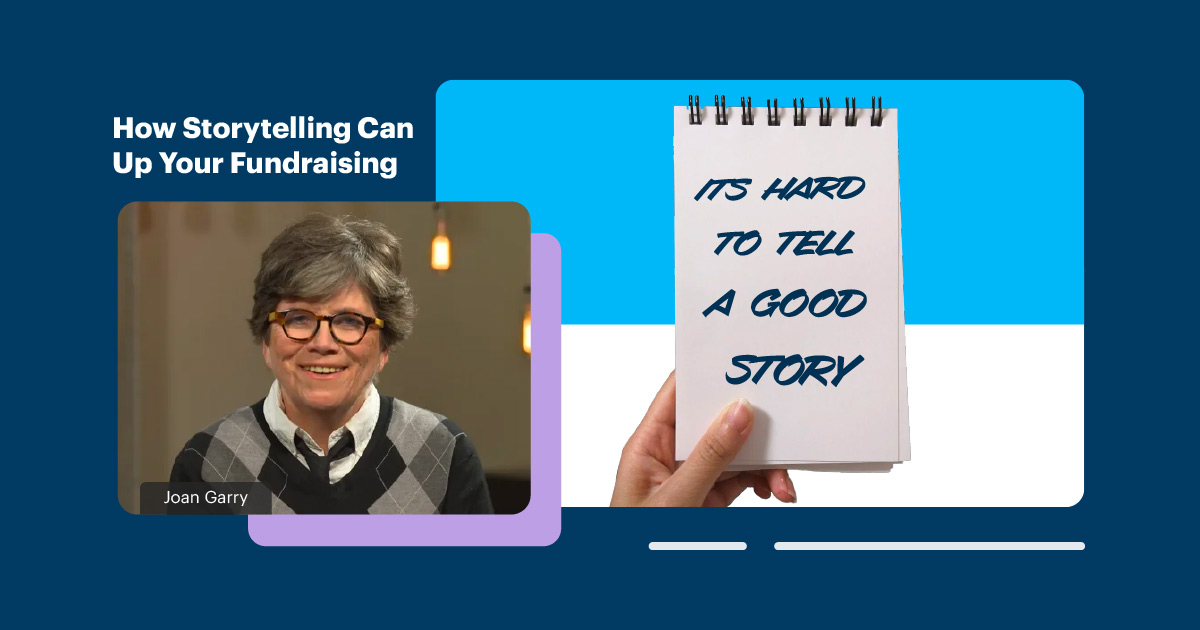
April 25, 2024

October 24, 2023 | Categories DonorPerfect Fundraising Software, Featured, Fundraising Strategies, Partners
Get the dos and don’ts from Joan Garry
Who do you think is the perfect person to tell the story of your mission and organization? While it makes intuitive sense to immediately rally your most passionate staff member or supporter, take a moment to pause. Is your passion for your mission bringing your story to life, or is it actually getting in the way of making a great case for support? (Hint: check out the section at the end of the blog for more, but rest assured – you can harness your passion and go from rambling to delivering a strong case for support!)
We invited Joan Garry, founder of the Nonprofit Leadership Lab and long-time nonprofit executive and board leader, to share some practical tips for telling your story in a way that inspires others to take action. If you missed the webinar, you can watch it here!
Here are her 4 Dos and 4 Don’ts for incorporating the craft of storytelling into your fundraising strategy.
When someone casually asks about what you do for work or what your nonprofit does for your community, you could tell them you’re a fundraiser for an adult literacy advocacy organization and you help people in your community develop the reading, writing, technology, and math skills they need to thrive independently. Not bad, right?
Or, you could tell them about how you’re a fundraiser for an adult literacy advocacy organization, and just last week you celebrated with one of the students you’re working with: he just signed the lease for his first apartment after finally getting his GED and a full time job in quick succession. Seeing the way he now carries himself with confidence has made all of the effort completely worthwhile.
Which of these two do you think is more likely to intrigue a prospective donor and inspire them to learn more about your cause?
When you dedicate your work, and possibly even your entire career, to solving a particular social challenge, it’s easy to fall into the assumption that other people care as much about your mission as you do. It consumes your entire day, and you’re likely swimming in jargon and alphabet soup full of acronyms.
But try thinking about the organizations you support and how you’d like them to communicate with you. You probably aren’t reading their appeals with a dictionary by your side or googling unfamiliar terms, and it’s safe to assume your readers aren’t, either.
When telling your story, use language that’s clear, concise, and doesn’t require a great deal of insider knowledge to understand. You want to capture your audience’s hearts and drive them to take action, and loading your language up with hyper-specific vocabulary will only get in the way.
When building your nonprofit’s bank of fundraising stories, one of the best questions you can ask yourself is simply, “So what?”
Using a story to illustrate the impact of your nonprofit’s day-to-day activities showcases the real value you add to your community. What does it matter if you hit your internal fundraising goal, or kept costs low, or any other measure of organizational success, if these figures obscure the actual difference you’re making?
Try it now: pick one event, beneficiary, program, or initiative and write or speak about it as if you’re talking with a donor. What might motivate them to support you right now?
While lists are a great place to start brainstorming, they don’t provide a complete narrative and don’t give your audience a “why” for taking action. Lists are a tempting tool to lean on for appeals – annual appeals in particular – since they provide and easy way to showcase all of your accomplishments and how your community of donors made them possible.
Rather than just listing programs, try thinking of your organization as a hub and spokes, with each program being a line that connects to the center. What’s in the center? How does each program support that center? Is there a narrative through line that ties these programs together in a clear way, or would it be beneficial to focus on one or a small handful of programs for a particular communication?
Want more resources for nonprofit storytelling? The 2022 DonorPerfect Community Conference, themed Stories Worth Sharing, centered around translating the incredible work our nonprofit partners do for their communities into stories that inspire action and support. Get a recap of the conference, links to the sessions, and more!
Inviting your audience to be an active participant in your storytelling has a number of benefits: it helps them feel more connected to you, and your mission by extension; and it prompts your listeners to think carefully about your message and what their role in your mission might be. Here are some examples to use to start brainstorming specific questions for your own mission and community.
Need: People without personal cars in a rural community lack access to reliable public transportation.
Question: “But what if that noise Sasha’s car is making turns out to be something more serious? How will she keep up on bills and necessities if she can’t make it to work?”
Need: Middle and high school aged children in your neighborhood don’t have accessible after-school sports.
Question: “But what about the kids like Madi and Courtnee, who aren’t interested in pursuing athletic scholarships, but want an environment where they can play with their friends, learn vital leadership skills, and enjoy all of the benefits of playing on the same team?”
“Mission statements,” Joan Garry half-joked, “often sound like an incomprehensible pledge of allegiance.” There’s more than a nugget of truth here! Mission and vision statements are usually the product of a committee made up of a variety of voices and opinions, and are so wordsmithed and polished that they sometimes even lose a little of their meaning.
Your mission statement is a powerful way to unify your team around a clear and shared cause, but people don’t naturally speak with the same language used in mission statements, so leading with your mission statement may sound clunky or overly formal. Try using your mission statement as a jumping off point. You could even plug your mission statement into a generative AI tool and ask it for ideas on how to phrase it in a variety of voices.
Remember, if you can’t clearly explain what you do to a fifteen-year-old in under a minute, you need to go back to the drawing board.
Now that you have your storytelling basics and talking points downpat, you can invite your passion for your mission back to the party. Your current and prospective donors will find reassurance in knowing that you all deeply care about the same cause, and they’ll trust that you’re the right person for the job when they can hear the enthusiasm in your voice (written or spoken).
Of course, this will vary depending on your audience, but if you’re willing to take a small risk, try testing appeals with a conversational tone, passionate language, and the formality you might use with a friend or family member. Let your drive to live out your mission shine through in your asks, and your audience will be inspired to join you!
Want more storytelling tips from the experts at DonorPerfect? Learn how to Multiply the Impact of Your Nonprofit through Storytelling! You can also check out the rest of our Nonprofit Technology & Fundraising Blog, written by communications experts and former fundraisers.
That said, it’s possible to be too passionate in your communications. Give your audiences just enough information to excite them about the possibility of giving, learning more, volunteering, or joining your next event. If you overwhelm them with too many stats, it won’t matter how impressive they are if your readers get bored.
Think about the information you would want to receive from a nonprofit you support but in a subject area outside of your usual expertise. See what happens when you stick to those key points.
Joan Garry recommends thinking of yourself as a storyteller/ambassador – as someone who invites and entices others into taking meaningful action toward living out your nonprofit’s mission. By framing yourself as a credible messenger delivering a compelling story, you’re sure to generate more resources for your organization.
If you want more resources, conferences, how-to guides, and a community of over 50,000 nonprofit professionals to learn from, DonorPerfect has you covered! We’re way more than your donor database – we’re your true partner in fundraising success. Sign up for a free demo today to see how you can boost your fundraising results by 25% in your first year with us!
Want to learn more from Joan Garry? Check out the Nonprofit Leadership Lab! DonorPerfect clients and friends get 25% off their first year. Get your exclusive discount now!